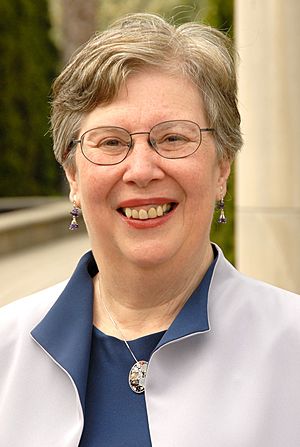Helen M. Berman facts for kids
Quick facts for kids
Helen Berman
|
|
|---|---|

Helen Berman in 2008.
|
|
| Born |
Helen Miriam Berman
1943 (age 81–82) Chicago, Illinois
|
| Alma mater | |
| Spouse(s) |
|
| Children | Jason Asher Young |
| Awards |
|
| Scientific career | |
| Fields |
|
| Institutions | Rutgers University |
| Thesis | The Crystal Structures of Alpha Prime and Beta-D-Mannitol, Galacticol, Methyl Aalpha-D-Glucopyranoside and Hydroxyurea (1967) |
| Doctoral advisor | George A. Jeffrey |
| Other academic advisors | Barbara Low, Jenny Glusker |
Helen Miriam Berman is a very important scientist. She is a professor of chemistry at Rutgers University. She used to lead a big project called the RCSB Protein Data Bank. This project helps scientists around the world share information about tiny parts of living things.
Helen Berman is a structural biologist. This means she studies the shapes of molecules like proteins and DNA. She also looks at how water affects these molecules. She started the Nucleic Acid Database and helped create a huge knowledge base for protein structures.
Contents
Early Life and Education
Helen Berman was born in Chicago, Illinois, in 1943. She grew up in Brooklyn, New York. Her father was a doctor, and her mother helped manage his office.
From a young age, Helen loved science. Her father, who worked very hard, inspired her to become a scientist or a doctor. Her mother taught her the importance of helping the community.
Discovering Crystallography
When Helen was in high school, she worked in a lab at Barnard College. The scientist there, Ingrith Deyrup, encouraged her to attend Barnard. During college, Helen worked in another lab at Columbia University.
It was there that she learned about crystallography. This is a way to figure out the exact shape of molecules using X-rays. Helen found this work fascinating, and it became her lifelong passion. She earned her chemistry degree from Barnard in 1964.
After Barnard, Helen went to the University of Pittsburgh for graduate school. She chose this university because it was one of the few places that taught crystallography. She studied how carbohydrates are structured and earned her Ph.D. in 1967. She stayed at the University of Pittsburgh for two more years to continue her research.
A Career in Science
In 1969, Helen Berman moved to the Fox Chase Cancer Center in Philadelphia. She worked in Jenny P. Glusker's lab. By 1973, she started her own research program there. At Fox Chase, she became very interested in the structures of nucleic acids (like DNA) and bioinformatics. Bioinformatics is about using computers to organize and understand biological data. She knew that organizing data well would help many other scientists.
Creating Important Databases
In 1971, Helen attended a meeting where scientists decided they needed a way to store information about protein structures. This led to the creation of the Protein Data Bank (PDB). This database became a central place for scientists to share their discoveries.
In 1989, Helen moved to Rutgers University. In 1992, she helped start the Nucleic Acid Database (NDB). This database collects and shares information specifically about nucleic acid structures. At Rutgers, she also studied how nucleic acids interact with proteins. She even researched the structure of collagen, which is a key protein in our bodies.
Leading the Protein Data Bank
In 1998, Helen Berman and Philip Bourne won a contract to manage the Protein Data Bank. The PDB then moved to the Research Collaboratory for Structural Bioinformatics (RCSB). This was a partnership between Rutgers and the University of California, San Diego.
Helen and her team completely redesigned the PDB. They added new tools and made it easier for scientists to search the database. In 2003, Helen founded the worldwide Protein Data Bank (wwPDB). This is a global partnership that manages the PDB data. It includes centers in Europe and Japan, making it a truly international effort. As of July 2025, the NDB holds over 9,600 nucleic acid structures. The PDB holds more than 142,000 macromolecular structures.
Helen also led the Protein Structure Initiative Structural Genomics Knowledgebase. This project, launched in 2008, provides up-to-date research data for scientists.
Community Involvement
Helen Berman has been very active in the scientific community. She was the president of the American Crystallographic Association in 1988. She has also advised important organizations like the National Institutes of Health. Her research has been published in many scientific journals.
Helen was also the creator and executive producer of a documentary series called "Target Zero." These films explain the medical and social aspects of HIV treatment. They share real patient stories and interviews with doctors and scientists. The series helps people understand the science behind treatments and the need for caring patient support.
Awards and Recognition
Helen Berman has received many awards for her important work:
- New Jersey Woman of Achievement (1993)
- Fellow, American Association for the Advancement of Science (1996)
- Outstanding Woman Scientist Award (1999)
- Distinguished Service Award, Biophysical Society (2000)
- M.J. Buerger Award, American Crystallographic Association (2006)
- Carl Brändén Award from the Protein Society (2012)
- DeLano Award for Computational Biosciences (2013)
- Benjamin Franklin Award for Open Access in the Life Sciences (2014)
Personal Life
Helen Berman has been married twice. She has a son named Jason Asher Young, who was born in 1979 and is a physicist.
In the 1980s, Helen faced a health challenge. This experience made her even more focused on her life and career. It also made her want to support other women going through similar situations.
See also
 In Spanish: Helen M. Berman para niños
In Spanish: Helen M. Berman para niños

